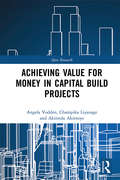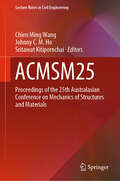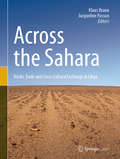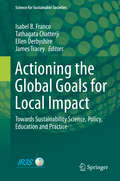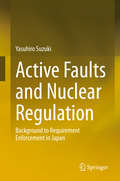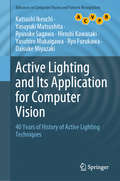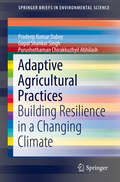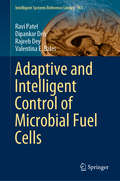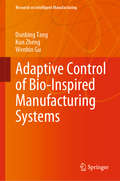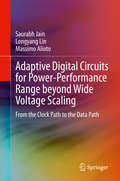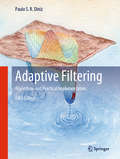- Table View
- List View
Achieving Value for Money in Capital Build Projects (Spon Research)
by Angela Vodden Champika Liyanage Akintola AkintoyeThis book is the first to bring together academic and practitioner views of Value for Money (VFM). VFM has been used to assess whether or not an organisation has obtained the maximum benefit within the resources available to it. A concept used by the public sector to assess the benefits of major built environment projects, it has become a major tenet of public private partnerships, capital project infrastructure and civil engineering megaprojects. This book presents and discusses the various debates surrounding the concept of Value for Money. It provides an international perspective on VFM by drawing upon the existing and fast developing body of principles and practices for Capital Build Projects. Readers will gain a level of understanding of the issues involved, the challenges, opportunities and the support mechanisms and protocols required for implementation of VFM in capital building development. Ultimately, the book presents a protocol that has been developed to track and monitor the VFM of a capital project from day 1, an Equilibrium Testing Mechanism (ETM) developed by the authors. This testing mechanism allows each of the parties to a project to monitor their VFM position at any given stage of a project from the beginning to the end of the build stage and beyond as necessary. This book is both a useful reference for researchers and a practical guide for the construction and engineering industry.
ACMSM25: Proceedings of the 25th Australasian Conference on Mechanics of Structures and Materials (Lecture Notes in Civil Engineering #37)
by Chien Ming Wang Johnny C. M. Ho Sritawat KitipornchaiThis book presents articles from The Australasian Conference on the Mechanics of Structures and Materials (ACMSM25 held in Brisbane, December 2018), celebrating the 50th anniversary of the conference. First held in Sydney in 1967, it is one of the longest running conferences of its kind, taking place every 2–3 years in Australia or New Zealand. Bringing together international experts and leaders to disseminate recent research findings in the fields of structural mechanics, civil engineering and materials, it offers a forum for participants from around the world to review, discuss and present the latest developments in the broad discipline of mechanics and materials in civil engineering.
Acoustic And Non-Acoustic Performance Coal Bottom Ash Concrete (SpringerBriefs in Applied Sciences and Technology)
by Shahiron Shahidan Nurul Izzati Raihan Ramzi HannanThis book highlights the acoustic performance of concrete made with Coal Bottom Ash (CBA) that has contributed to environmental issues. The usage of CBA in concrete can be recommended as good concrete due to its absorption properties. This book focuses on the principles and techniques employed in acoustic design. The book first elaborates on the perception of noise and properties of noise, followed by physical data, units and measurements. Finally, it takes a look at acoustic analysis which includes acoustic performance effects using different volumes of CBA, density and porosity of concrete.
Acoustic Levitation: From Physics to Applications
by Duyang ZangThis book systematically introduces readers to the fundamental physics and a broad range of applications of acoustic levitation, one of the most promising techniques for the container-free handling of small solid particles and liquid droplets. As it does away with the need for solid walls and can easily be incorporated into analysis instruments, acoustic levitation has attracted considerable research interest in many fields, from fluid physics to material science. The book offers a comprehensive overview of acoustic levitation, including the history of acoustic radiation force; the design and development of acoustic levitators; the technology’s applications, ranging from drop dynamics studies to bio/chemical analysis; and the insightful perspectives that the technique provides. It also discusses the latest advances in the field, from experiments to numerical simulations. As such, the book provides readers with a clearer understanding of acoustic levitation, while also stimulating new research areas for scientists and engineers in physics, chemistry, biology, medicine and other related fields.
Across the Sahara: Tracks, Trade and Cross-Cultural Exchange in Libya
by Klaus Braun Jacqueline PassonThis open access book provides a multi-perspective approach to the caravan trade in the Sahara during the 19th century. Based on travelogues from European travelers, recently found Arab sources, historical maps and results from several expeditions, the book gives an overview of the historical periods of the caravan trade as well as detailed information about the infrastructure which was necessary to establish those trade networks. Included are a variety of unique historical and recent maps as well as remote sensing images of the important trade routes and the corresponding historic oases. To give a deeper understanding of how those trading networks work, aspects such as culturally influenced concepts of spatial orientation are discussed. The book aims to be a useful reference for the caravan trade in the Sahara, that can be recommended both to students and to specialists and researchers in the field of Geography, History and African Studies.
Actioning the Global Goals for Local Impact: Towards Sustainability Science, Policy, Education and Practice (Science for Sustainable Societies)
by Isabel B. Franco Tathagata Chatterji Ellen Derbyshire James TraceyThis book highlights the value of sustainability science in newly emerging and innovative approaches to research, education, capacity building and practice in order to transform rhetoric into impact sustainability. Presenting case studies from various industries, sectors and geographical contexts targeting the seventeen (Sustainable development Goals (SDGs) outlined in the 2030 Agenda, it provides insightful recommendations to create sustainable impact while at the same time achieving the global goals. The book addresses the fundamental question of how sustainability rehtoric can be transformed into impact sustainability research, education and capacity building and as a result, how existing approaches in science, curricula and practice are mitigating the demands emerging from addressing global sustainable development in an impactful and innovative manner. Providing recommendations for impact sustainability in science, curriculum on how to address pressing sustainability issues and contribute toward achieving the SDGs, this book is an essential reference for both academics and professionals.
Active Balancing of Bike Sharing Systems (Lecture Notes in Mobility)
by Jan BrinkmannThis book reports on an operational management approach to improving bike-sharing systems by compensating for fluctuating demand patterns. The aim is to redistribute bikes within the system, allowing it to be “actively” balanced. The book describes a mathematical model, as well as data-driven and simulation-based approaches. Further, it shows how these elements can be combined in a decision-making support system for service providers. In closing, the book uses real-world data to evaluate the method developed and demonstrates that it can successfully anticipate changes in demand, thus supporting efficient scheduling of transport vehicles to manually relocate bikes between stations.
Active Control of Bidirectional Structural Vibration (SpringerBriefs in Applied Sciences and Technology)
by Wen Yu Satyam PaulThis book focuses on safeguarding civil structures and residents from natural hazards such as earthquakes through the use of active control. It proposes novel proportional-derivative (PD) and proportional-integral-derivative (PID) controllers, as well as discrete-time sliding mode controllers (DSMCs) for the vibration control of structures involving nonlinearities. Fuzzy logic techniques are used to compensate for nonlinearities. The first part of the book addresses modelling and feedback control in inelastic structures and presents a design for PD/PID controllers. In the second part, classical PD/PID and type-2 fuzzy control techniques are combined to compensate for uncertainties in the structures of buildings. The methodology for tuning the gains of PD/PID is obtained using Lyapunov stability theory, and the system’s stability is verified. Lastly, the book puts forward a DSMC design that does not require system parameters, allowing it to be more flexibly applied. All program codes used in the paper are presented in a MATLAB®/Simulink® environment. Given its scope, the book will be of interest to mechanical and civil engineers, and to advanced undergraduate and graduate engineering students in the areas of structural engineering, structural vibration, and advanced control.
Active Faults and Nuclear Regulation: Background to Requirement Enforcement in Japan
by Yasuhiro SuzukiThis book reviews the active faults around nuclear power plants in Japan and recommends an optimal method of nuclear power regulation controlled by the Nuclear Regulation Authority of Japan. The active faults around nuclear power plants have been underestimated in Japan since the latter half of the 20th century. However, based on the lessons learned from the Fukushima nuclear power plant accident, the book sheds light on why the risks of active faults were underestimated, and discusses the optimal scientific method of assessing those risks. Further, the author shares his experiences in the new standard for nuclear regulation creation team and in the active fault survey at the Nuclear Regulation Authority of Japan. This book is a valuable resource for students, researchers, academic and policy-makers, as well as non-experts interested in nuclear safety.
Active Lighting and Its Application for Computer Vision: 40 Years of History of Active Lighting Techniques (Advances in Computer Vision and Pattern Recognition)
by Katsushi Ikeuchi Yasuyuki Matsushita Ryusuke Sagawa Hiroshi Kawasaki Yasuhiro Mukaigawa Ryo Furukawa Daisuke MiyazakiThis book describes active illumination techniques in computer vision. We can classify computer vision techniques into two classes: passive and active techniques. Passive techniques observe the scene statically and analyse it as is. Active techniques give the scene some actions and try to facilitate the analysis. In particular, active illumination techniques project specific light, for which the characteristics are known beforehand, to a target scene to enable stable and accurate analysis of the scene. Traditional passive techniques have a fundamental limitation. The external world surrounding us is three-dimensional; the image projected on a retina or an imaging device is two-dimensional. That is, reduction of one dimension has occurred. Active illumination techniques compensate for the dimensional reduction by actively controlling the illumination. The demand for reliable vision sensors is rapidly increasing in many application areas, such as robotics and medical image analysis. This book explains this new endeavour to explore the augmentation of reduced dimensions in computer vision. This book consists of three parts: basic concepts, techniques, and applications. The first part explains the basic concepts for understanding active illumination techniques. In particular, the basic concepts of optics are explained so that researchers and engineers outside the field can understand the later chapters. The second part explains currently available active illumination techniques, covering many techniques developed by the authors. The final part shows how such active illumination techniques can be applied to various domains, describing the issue to be overcome by active illumination techniques and the advantages of using these techniques. This book is primarily aimed at 4th year undergraduate and 1st year graduate students, and will also help engineers from fields beyond computer vision to use active illumination techniques. Additionally, the book is suitable as course material for technical seminars.
Actuators and Their Applications: Fundamentals, Principles, Materials, and Emerging Technologies
by Inamuddin Rajender Boddula Abdullah M. AsiriAs demand has increased for new types of equipment that are more suited to the ever-evolving world of industry, demand for both new and traditional types of actuators has soared. From automotive and aeronautical to biomedical and robotics, engineers are constantly developing actuating devices that are adapted to their particular needs in their particular field, and actuators are used in almost every field of engineering that there is. This volume not only lays out the fundamentals of actuators, such as how they operate, the different kinds, and their various applications, but it also informs the engineer or student about the new actuators that are being developed and the state-of-the-art of actuators. Edited and written by highly experienced and well-respected engineers with a deep understanding of their subject, there is no other volume on actuators that is more current or comprehensive. Whether as a guide for the latest innovations in actuators, a refresher reference work for the veteran engineer, or an introductory text for the engineering student, this is a must-have for any engineer’s or university’s library. Covering the theory and the practical applications, this breakthrough volume is a “one stop shop” for any engineer or student interested in actuators.
Actuators and Their Applications: Fundamentals, Principles, Materials, and Emerging Technologies (Materials Research Foundations Ser.)
by Rajender Boddula Inamuddin Abdullah M. AsiriAs demand has increased for new types of equipment that are more suited to the ever-evolving world of industry, demand for both new and traditional types of actuators has soared. From automotive and aeronautical to biomedical and robotics, engineers are constantly developing actuating devices that are adapted to their particular needs in their particular field, and actuators are used in almost every field of engineering that there is. This volume not only lays out the fundamentals of actuators, such as how they operate, the different kinds, and their various applications, but it also informs the engineer or student about the new actuators that are being developed and the state-of-the-art of actuators. Edited and written by highly experienced and well-respected engineers with a deep understanding of their subject, there is no other volume on actuators that is more current or comprehensive. Whether as a guide for the latest innovations in actuators, a refresher reference work for the veteran engineer, or an introductory text for the engineering student, this is a must-have for any engineer’s or university’s library. Covering the theory and the practical applications, this breakthrough volume is a “one stop shop” for any engineer or student interested in actuators.
Adaptive Agricultural Practices: Building Resilience in a Changing Climate (SpringerBriefs in Environmental Science)
by Pradeep Kumar Dubey Gopal Shankar Singh Purushothaman Chirakkuzhyil AbhilashThis brief explores several adaptive agricultural practices from around the world to fulfill current and future agricultural demands for food security due to the challenges posed by climate change and growing global population. Readers will discover how farmers adapt to environmental changes by adopting various agronomic practices at crop, farm and landscape levels. Particular attention is given to systemic and transformational adaptation strategies employed by farmers such as mulching, organic farming and crop diversification. This is a highly informative and carefully presented book that provides insights on how crops can build up resilience against periods of drought, high salinity, disasters such as floods, and diseases. The policy implications and future prospects of these adaptation strategies are also addressed. Environmental and plant scientists, agronomists and researchers in climate sciences will find this book interesting.
Adaptive and Intelligent Control of Microbial Fuel Cells (Intelligent Systems Reference Library #161)
by Ravi Patel Dipankar Deb Rajeeb Dey Valentina E. BalasThis book addresses a range of solutions and effective control techniques for Microbial Fuel Cells (MFCs), intended as a response to the increased energy consumption and wastewater production stemming from globalization. It describes the fundamentals of MFCs and control-oriented mathematical models, and provides detailed information on uncertain parameters. Various control techniques like robust control with LMI, adaptive backstepping control, and exact linearization control are developed for different mathematical models. In turn, the book elaborates on the basics of adaptive control, presenting several methods in detail. It also demonstrates how MFCs can be developed at the laboratory level, equipping readers to develop their own MFCs for experimental purposes. In closing, it develops a transfer function model for MFCs by combining a system identification technique and model reference adaptive control techniques. By addressing one of the most promising sources of clean and renewable energy, this book provides a viable solution for meeting the world’s increasing energy demands.
Adaptive Control of Bio-Inspired Manufacturing Systems (Research on Intelligent Manufacturing)
by Dunbing Tang Kun Zheng Wenbin GuThis book introduces state-of-the-art models and methods based on the neuroendocrine-immune-inspired approaches in the field of manufacturing control systems. It develops various bio-inspired intelligent approaches for multiple applications in order to efficiently generate production plans and control solutions and agilely deal with the frequent unexpected disturbances at the shop floor level. It also provides an introduction to bio-inspired manufacturing systems with intelligent control structures and the latest technologies. Further, the book describes recent advances in the bio-inspired methodology for a high-level adaptability in manufacturing systems, including the bio-inspired control architecture and the implementation of intelligent and adaptive control approaches based on neuroendocrine-immune mechanisms and hormone-regulation principles. It offers a valuable resource for graduate students, researchers and engineers in the fields of production management, manufacturing system control and related areas.
Adaptive Digital Circuits for Power-Performance Range beyond Wide Voltage Scaling: From the Clock Path to the Data Path
by Saurabh Jain Longyang Lin Massimo AliotoThis book offers the first comprehensive coverage of digital design techniques to expand the power-performance tradeoff well beyond that allowed by conventional wide voltage scaling. Compared to conventional fixed designs, the approach described in this book makes digital circuits more versatile and adaptive, allowing simultaneous optimization at both ends of the power-performance spectrum. Drop-in solutions for fully automated and low-effort design based on commercial CAD tools are discussed extensively for processors, accelerators and on-chip memories, and are applicable to prominent applications (e.g., IoT, AI, wearables, biomedical). Through the higher power-performance versatility techniques described in this book, readers are enabled to reduce the design effort through reuse of the same digital design instance, across a wide range of applications. All concepts the authors discuss are demonstrated by dedicated testchip designs and experimental results. To make the results immediately usable by the reader, all the scripts necessary to create automated design flows based on commercial tools are provided and explained.
Adaptive Filtering: Algorithms and Practical Implementation (The\springer International Series In Engineering And Computer Science Ser. #694)
by Paulo S. DinizIn the fifth edition of this textbook, author Paulo S.R. Diniz presents updated text on the basic concepts of adaptive signal processing and adaptive filtering. He first introduces the main classes of adaptive filtering algorithms in a unified framework, using clear notations that facilitate actual implementation. Algorithms are described in tables, which are detailed enough to allow the reader to verify the covered concepts. Examples address up-to-date problems drawn from actual applications. Several chapters are expanded and a new chapter ‘Kalman Filtering’ is included. The book provides a concise background on adaptive filtering, including the family of LMS, affine projection, RLS, set-membership algorithms and Kalman filters, as well as nonlinear, sub-band, blind, IIR adaptive filtering, and more. Problems are included at the end of chapters. A MATLAB package is provided so the reader can solve new problems and test algorithms. The book also offers easy access to working algorithms for practicing engineers.
Adaptive-Robust Control with Limited Knowledge on Systems Dynamics: An Artificial Input Delay Approach and Beyond (Studies in Systems, Decision and Control #257)
by Spandan Roy Indra Narayan KarThe book investigates the role of artificial input delay in approximating unknown system dynamics, referred to as time-delayed control (TDC), and provides novel solutions to current design issues in TDC. Its central focus is on designing adaptive-switching gain-based robust control (ARC) for a class of Euler–Lagrange (EL) systems with minimal or no knowledge of the system dynamics parameters. The newly proposed TDC-based ARC tackles the commonly observed over- and under-estimation issues in switching gain. The consideration of EL systems lends a practical perspective on the proposed methods, and each chapter is supplemented by relevant experimental data. The book offers a unique resource for researchers in the areas of ARC and TDC alike, and covers the state of the art, new algorithms, and future directions.
Adaptive Strategies for Water Heritage: Past, Present and Future
by Carola HeinThis Open Access book, building on research initiated by scholars from the Leiden-Delft-Erasmus Centre for Global Heritage and Development (CHGD) and ICOMOS Netherlands, presents multidisciplinary research that connects water to heritage. Through twenty-one chapters it explores landscapes, cities, engineering structures and buildings from around the world. It describes how people have actively shaped the course, form and function of water for human settlement and the development of civilizations, establishing socio-economic structures, policies and cultures; a rich world of narratives, laws and practices; and an extensive network of infrastructure, buildings and urban form. The book is organized in five thematic sections that link practices of the past to the design of the present and visions of the future: part I discusses drinking water management; part II addresses water use in agriculture; part III explores water management for land reclamation and defense; part IV examines river and coastal planning; and part V focuses on port cities and waterfront regeneration. Today, the many complex systems of the past are necessarily the basis for new systems that both preserve the past and manage water today: policy makers and designers can work together to recognize and build on the traditional knowledge and skills that old structure embody. This book argues that there is a need for a common agenda and an integrated policy that addresses the preservation, transformation and adaptive reuse of historic water-related structures. Throughout, it imagines how such efforts will help us develop sustainable futures for cities, landscapes and bodies of water.
Additive Manufacturing: Fundamentals and Advancements
by Manu Srivastava Sandeep Rathee Sachin Maheshwari TK KundraThere is a growing need for manufacturing optimization all over the world. The immense market of Additive Manufacturing (AM) technologies dictates a need for a book that will provide knowledge of the various aspects of AM for anyone interested in learning about this fast-growing topic. This book disseminates knowledge of AM amongst scholars at graduate level, post graduate level, doctoral level, as well as industry personnel. The objective is to offer a state-of-the-art book which covers all aspects of AM and incorporates all information regarding trends, historical developments, classifications, materials, tooling, software issues, dynamic design, principles, limitations, and communication interfaces in a one-stop resource. Features: Breaks down systematic coverage of various aspects of AM within four distinct sections Contains details of various AM techniques based on ASTM guidelines Discusses many AM applications with suitable illustrations Includes recent trends in the field of AM Covers engineering materials utilized as raw materials in AM Compares AM techniques with different traditional manufacturing methods
Additive Manufacturing: Fundamentals and Advancements
by Manu Srivastava Sandeep Rathee Sachin Maheshwari TK KundraThere is a growing need for manufacturing optimization all over the world. The immense market of Additive Manufacturing (AM) technologies dictates a need for a book that will provide knowledge of the various aspects of AM for anyone interested in learning about this fast-growing topic. This book disseminates knowledge of AM amongst scholars at graduate level, post graduate level, doctoral level, as well as industry personnel. The objective is to offer a state-of-the-art book which covers all aspects of AM and incorporates all information regarding trends, historical developments, classifications, materials, tooling, software issues, dynamic design, principles, limitations, and communication interfaces in a one-stop resource. Features: Breaks down systematic coverage of various aspects of AM within four distinct sections Contains details of various AM techniques based on ASTM guidelines Discusses many AM applications with suitable illustrations Includes recent trends in the field of AM Covers engineering materials utilized as raw materials in AM Compares AM techniques with different traditional manufacturing methods
Additive Manufacturing Hybrid Processes for Composites Systems (Advanced Structured Materials #129)
by António Torres Marques Sílvia Esteves João P. T. Pereira Luis Miguel OliveiraThis book focuses on the emerging additive manufacturing technology and its applications beyond state-of-the-art, fibre-reinforced thermoplastics. It also discusses the development of a hybrid, integrated process that combines additive and subtractive operations in a single-step platform, allowing CAD-to-Part production with freeform shapes using long or continuous fibre-reinforced thermoplastics. The book covers the entire value chain of this next-generation technology, from part design and materials composition to transformation stages, product evaluation, and end-of-life studies. Moreover, it addresses the following engineering issues: • Design rules for hybrid additive manufacturing; • Thermoplastic compounds for high-temperature and -strength applications; • Advanced extrusion heads and process concepts; • Hybridisation strategies; • Software ecosystems for hAM design, pre-processing, process planning, emulating and multi-axis processing; • 3D path generators for hAM based on a multi-objective optimisation algorithm that matches the recent curved adaptive slicing method with a new transversal scheme; • hAM parameters, real-time monitoring and closed-loop control; • Multiparametric nondestructive testing (NDT) tools customised for FRTP AM parts; • Sustainable manufacturing processes validated by advanced LCA/LCC models.
Additive Manufacturing Processes
by Sanjay KumarThis book provides a single-source reference to additive manufacturing, accessible to anyone with a basic background in engineering and materials science. Unlike other books on additive manufacturing that include coverages of things such as machine architecture, applications, business and present market conditions, this book focuses on providing comprehensive coverage of currently available additive manufacturing processes. All processes are explained with the help of various, original diagrams, useful for beginners and advanced researchers alike.Provides comprehensive coverages of all current processes available in additive manufacturing;Explains processes with the help of various original diagrams;Explains future process development at the last chapter, providing research outlook;Includes extensive references at the end of each chapter for further reading of original research.
Additive Manufacturing, Second Edition
by Amit Bandyopadhyay Susmita BoseThe field of additive manufacturing is growing dynamically as the interest is persisting from manufacturing sector, including other sectors as well. Conceptually, additive manufacturing is a way to build parts without using any part-specific tooling or dies from the computer-aided design (CAD) file of the part. Second edition of Additive Manufacturing highlights the latest advancements in the field, taking an application oriented approach. It includes new material on traditional polymer based rapid prototyping technologies, additive manufacturing of metals and alloys including related design issues. Each chapter comes with suggested reading, questions for instructors and PowerPoint slides.
Additive Manufacturing, Second Edition
by Amit Bandyopadhyay Susmita BoseThe field of additive manufacturing is growing dynamically as the interest is persisting from manufacturing sector, including other sectors as well. Conceptually, additive manufacturing is a way to build parts without using any part-specific tooling or dies from the computer-aided design (CAD) file of the part. Second edition of Additive Manufacturing highlights the latest advancements in the field, taking an application oriented approach. It includes new material on traditional polymer based rapid prototyping technologies, additive manufacturing of metals and alloys including related design issues. Each chapter comes with suggested reading, questions for instructors and PowerPoint slides.
